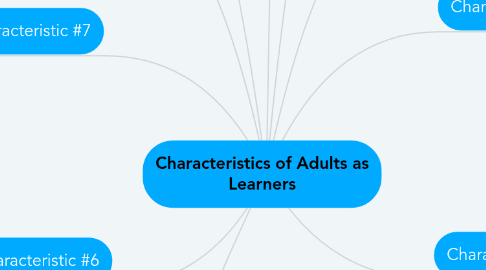
1. Characteristic #5
1.1. For most adults, the "student" role is a minor and secondary role
1.2. Multiple roles will cause most adults to have far less time and energy to read, study, or learn.
1.3. Implications
1.4. More flexibility in adult education programs than in traditional education. • Give assignments far ahead of time
2. Characteristic #6
2.1. Adult roles take energy and time to fulfill.
2.1.1. Implications
2.1.1.1. help learners to be realistic about the demands of learning and provide time management and study suggestions.
2.2. An important principle to understand is that learning takes time and energy.
3. Caracteristic #7
3.1. Many adults have had somewhat negative learning experiences in their traditional schooling.
3.1.1. Implications
3.1.1.1. Employ learning strategies that build higher confidence in adult learners.
3.1.1.2. Use collaborative learning approaches in the classroom can do much to alleviate anxiety.(i.e., turn the classroom from a competitive environment to a collaborative one)
3.2. poor reading skills, test anxiety, or other such learning barriers.
4. Characteristic #8
4.1. Adults tend to be somewhat resistant to changes
4.1.1. Implications
4.1.1.1. Adult learners need more explanation of the "why" of changes, not just the "how."
4.1.1.2. Link new concepts to older, understood, and accepted concepts for adult learners.
4.2. Youth tend to be more idealistic and are often open to change just for the sake of change.
5. Characteristic #9
5.1. Adults vary from each other as learners in terms of age and experiences much more than traditional age learners.
5.1.1. Implications
5.1.1.1. Allow more time for interaction between adults to allow learners to network together to sharing of perspectives and experiences.
5.1.1.2. Make effort to present material in a variety of ways to accommodate different learning styles.
5.2. Through collaboration in small groups, adults can benefit from their variety of experiences
6. Characteristic #10
6.1. As adults age, vision and hearing can also create barriers in educational programs.
6.1.1. Implications
6.1.1.1. • Pay more attention to the physical learning environment to compensate for aging issues.
6.2. As adult educators, we must pay much more attention to sound and lighting when dealing with adult learners.
7. Characteristic #1
7.1. Adults tend to be self directed, will resist learning and probably sabotage education efforts.
7.2. Implications
7.2.1. Include the adults in the planning of educational efforts
7.2.1.1. f
7.3. Peer relationship, rather than hierarchical
8. Characteristic #2
8.1. Adults tend to link any new learning to their prior learning.
8.2. Implications
8.2.1. Take the time to get to know more about the experiences of our learners and seek to help them to link new ideas to such prior learning.
8.2.2. Encourage discussion on how new ideas fit the experience of learners
9. Characteristic #3
9.1. Higher motivation is linked to the fact that most adult learning is voluntary.
9.2. Whenever an individual is able to choose to learn, s/he is much more motivated to learn.
9.3. Implications
9.3.1. Spend less effort trying to motivate adult learners and concentrate our time on facilitating the learning they are already motivated to pursue.
